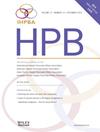Surface microdialysis to monitor hepatic metabolism in liver surgery
IF 2.4
3区 医学
Q2 GASTROENTEROLOGY & HEPATOLOGY
引用次数: 0
Abstract
Background
Microdialysis (μD) monitors local metabolism in tissues. Traditional μD requires intraparenchymal catheters, risking tissue damage, interfering with the analysis. This study evaluated the safety and feasibility of monitoring liver metabolism with a novel surface μD probe after liver resection.
Methods
Two μD catheters were attached to the liver surface intraoperatively. Concentrations of glucose, lactate, and pyruvate were determined and related to venous blood samples. Complications were registered 30 days postoperatively and graded according to Clavien–Dindo Classification and CTCAE guidelines.
Results
Samples were collected for a median of 4.7 days in 17 patients. No major complications related to μD were observed. The coefficients of variation for glucose, lactate, pyruvate, and the lactate/pyruvate ratio (L/P) were 18 %, 22 %, 28 %, and 21 %. Lactate in liver μD was significantly higher than in plasma and further increased in an ischemic area. Postoperative μD L/P was significantly correlated to a later increase in alanine aminotransferase. μD sampling from a hepatocellular carcinoma indicated elevated lactate compared with healthy liver.
Conclusions
Surface μD is a safe and feasible method to monitor liver metabolism postoperatively and may survey tumour metabolism in vivo. Biomarker trends can be monitored in vivo and may precede changes in systemic venous samples.
表面微透析监测肝脏手术中肝脏代谢。
背景:微透析(μD)监测组织的局部代谢。传统的μD需要在肺实质内插入导管,有组织损伤的风险,会干扰分析。本研究评估了一种新型表面μD探针在肝切除术后监测肝脏代谢的安全性和可行性。方法:术中采用两根μD导管贴置肝表面。葡萄糖、乳酸和丙酮酸的浓度被测定并与静脉血样本相关。术后30天记录并发症,并根据Clavien-Dindo分类和CTCAE指南进行分级。结果:17例患者的样本收集时间中位数为4.7天。未见与μD相关的重大并发症。葡萄糖、乳酸、丙酮酸和乳酸/丙酮酸比值(L/P)的变异系数分别为18%、22%、28%和21%。肝μD中乳酸浓度明显高于血浆,缺血区乳酸浓度进一步升高。术后μD L/P与后期丙氨酸转氨酶升高显著相关。肝细胞癌的μD样本显示,与健康肝脏相比,乳酸水平升高。结论:表面μD是一种安全可行的术后肝脏代谢监测方法,可用于体内肿瘤代谢监测。生物标志物的趋势可以在体内监测,并可能先于全身静脉样本的变化。
本文章由计算机程序翻译,如有差异,请以英文原文为准。
求助全文
约1分钟内获得全文
求助全文
来源期刊

Hpb
GASTROENTEROLOGY & HEPATOLOGY-SURGERY
CiteScore
5.60
自引率
3.40%
发文量
244
审稿时长
57 days
期刊介绍:
HPB is an international forum for clinical, scientific and educational communication.
Twelve issues a year bring the reader leading articles, expert reviews, original articles, images, editorials, and reader correspondence encompassing all aspects of benign and malignant hepatobiliary disease and its management. HPB features relevant aspects of clinical and translational research and practice.
Specific areas of interest include HPB diseases encountered globally by clinical practitioners in this specialist field of gastrointestinal surgery. The journal addresses the challenges faced in the management of cancer involving the liver, biliary system and pancreas. While surgical oncology represents a large part of HPB practice, submission of manuscripts relating to liver and pancreas transplantation, the treatment of benign conditions such as acute and chronic pancreatitis, and those relating to hepatobiliary infection and inflammation are also welcomed. There will be a focus on developing a multidisciplinary approach to diagnosis and treatment with endoscopic and laparoscopic approaches, radiological interventions and surgical techniques being strongly represented. HPB welcomes submission of manuscripts in all these areas and in scientific focused research that has clear clinical relevance to HPB surgical practice.
HPB aims to help its readers - surgeons, physicians, radiologists and basic scientists - to develop their knowledge and practice. HPB will be of interest to specialists involved in the management of hepatobiliary and pancreatic disease however will also inform those working in related fields.
Abstracted and Indexed in:
MEDLINE®
EMBASE
PubMed
Science Citation Index Expanded
Academic Search (EBSCO)
HPB is owned by the International Hepato-Pancreato-Biliary Association (IHPBA) and is also the official Journal of the American Hepato-Pancreato-Biliary Association (AHPBA), the Asian-Pacific Hepato Pancreatic Biliary Association (A-PHPBA) and the European-African Hepato-Pancreatic Biliary Association (E-AHPBA).
 求助内容:
求助内容: 应助结果提醒方式:
应助结果提醒方式:


